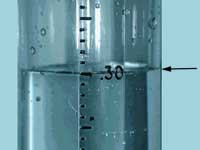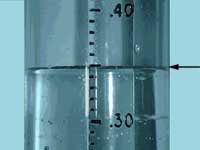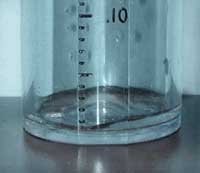|
How to read your rain gauge. It is important to be as accurate as possible when reading your gauge. Scientists, engineers, and other professionals may use your data. The rain gauge is composed of three parts: a funnel, a measuring tube, and a 4-inch diameter overflow tube, and a mounting bracket. The funnel directs the precipitation into the measuring tube and magnifies it by a factor of 10. This allows observers to report rainfall to the nearest 0.01" (one hundredth of an inch). The measuring tube, when full, will hold "one inch" of rainfall. When it rains more than one inch, the excess water collects in the overflow tube. Reading the rain gauge is a very easy thing to do, but mistakes can occur. Here are several situations that you may encounter when reading your rain gauge and how you should deal with them. | 
|
1. The surface of the water in the gauge looks curved. How do I know where to read?As water fills up the measuring tube, a curved surface is formed called a meniscus. This meniscus is formed by the surface tension of a liquid in contact with the sides of the tube. Always read the base of the meniscus when taking measurements. Here is an illustration to help you understand this process.
| 
|
2. What do the numbers mean on the side of the measuring tube and how do I read them?The measuring tube is designed to magnify the rainwater. This allows more precise readings. Remember that the measuring tube when full holds one inch of precipitation. The measuring tube is divided, marked and labeled in smaller parts (increments) in tenths and hundredths. Imagine that the gauge is equivalent to a dollar, but instead of having one paper bill you have ten dimes or one hundred pennies. The smallest line on the measuring tube would equal one penny. We would write in our checkbook that we have 0.01 dollars, and when recording rainfall you would write 0.01 inches. This is also called one hundredth of an inch. The longer lines on the measuring tube would be like a dime. We record a dime in our checkbook as 0.10 or if you have two dimes 0.20. When recording rainfall that has reached these lines we write them in the same way 0.20 If rain has reached the line .30, you would say that you had three tenths of an inch of rain or 30 one-hundredths. Here is an illustration of the calibrated measurement tube of the rain gauge that contains 30 one-hundredths of an inch (0.30 inches). |  |
3. What if I have a measurement on the middle line between 0.30 and 0.40?
 | This would be saying that you have three dimes and five pennies. You would record this as 0.35 inches and report that you have 35 hundredths of an inch of rain. There are nine smaller lines (hundredth marks) between each larger lines (tenth marks). This means that you will never have a measurement like 0.0599, for this measurement would be 0.06. |
Always remember that the greatest number of decimal places you will have is two. Please do not use your ruler when taking measurements. A ruler is not calibrated to the measuring tube and will affect the data. The most common error observers make is confusing tenths and hundredths. Please be careful, and don't make this mistake. 4. I know some rain fell, but there is nothing (or just a tiny bit but less than 0.01 inch) in my gauge. What should I report? We call this a "trace" of rain. This should be reported as "T" on your reports. Even if there were just a few drops that don't even dampen the gauge, you should still report a trace. |  |
5. What if there is no precipitation to report? Just record zero (0.00). It is very important to report 0.00, especially on days when there are scattered storms in the area. It is just as important to know where it didn't rain, as it is to know how much it rained where it did. 6. What do I do if the inside measuring tube is full? We can determine that more than one inch of rain has fallen by simply observing that the inside measuring tube is full and the additional water has spilled out into the larger container. Remember that the measuring tube will only hold one inch of water. Follow these steps when measuring rainfall more than one inch. Step 1. You will first need to read the precipitation in the measuring tube, record it, and empty the water in the measuring tube. Do not empty out the water that has collected in the Overflow Tube. Step 2. You will need to carefully pour the remaining water, from the overflow tube, into the measuring tube, record it, and add up the totals. The easiest way of doing this is by pouring the water into the measuring tube a little bit at a time. You do not have to fill up the tube to the one inch mark every time, rather fill up the tube half or three quarters of the way, record it, and add up the totals. Be careful not to spill any precipitation. When in doubt, place a bucket or other large container under the gauge as you pour, so that you can collect the water if you do happen to spill. If more than 2.00 inches of rain fell, you will have to repeat the process several times. Make sure you write down each rainfall quantity and add up the total. If you don't write it down immediately, you could forget. 7. Do I report morning dew that has collected in my rain gauge? On damp, dewy spring and summer mornings a few drops of moisture may collect in your rain gauge. Do not to report this as rain. If the only moisture in your gauge came from dew (rarely will dew collect to more than 0.01 inch), report "0.00". 8. Should I keep a written record of my precipitation data? Yes, it is important to maintain a written record of your data. This gives you a permanent record and gives us a backup in case we have computer or phone problems. This is also important if we find that your data have been entered erroneously into the CoCoRaHS computer system. It might happen that a CoCoRaHS student intern spots an suspicious or erroneous report for your station. If so, they may contact you and discuss it with you. Keep your written records handy. Please do not be offended, we are simply trying to collect the best data as possible. You can print out our CoCoRaHS Precipitation and Snow Measurement Form to record your data on. 9. What If I leave for a weekend or for a vacation and find precipitation in the gauge when I get back? You need to enter your data as a multi-day report. Click on the "Multiple Day Accumulation Form" button. Enter the precipitation amount and the dates, the first date is generally the day after you left and the second date is the day you returned and emptied the rain gauge. Make sure that you don't accidentally write over good data by entering a date that is too early. Please also let us know in the comments if you think you know on which day the precipitation fell.
|